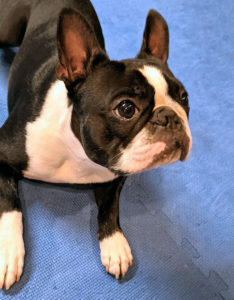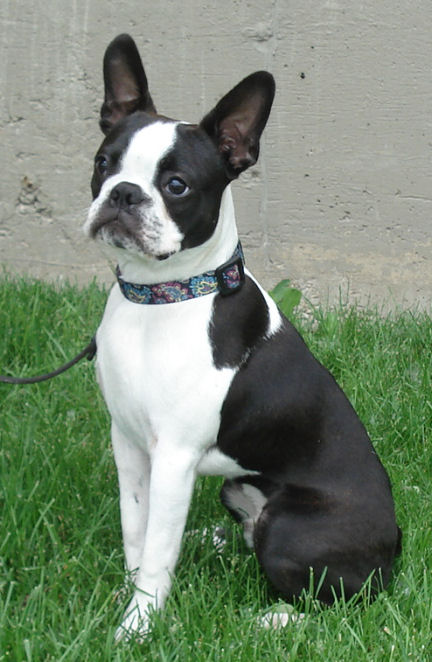D is for dog. It’s also for the three things that can torpedo any behavior, trick, or exercise. The three dog training “d’s” are Distance, Duration, and Distraction.
You need all three if you want to be successful in any dog sport or performance event. They matter for household obedience, too. But you can’t “work” on all of them at once. Pick one at a time. There are games you can play for each one, but only one per 2-Minute session.
Distance is hard
If you’re teaching your dog “Stay!” the three “d’s” are crucial components of the behavior. Whether you’re letting the plumber in the house, carrying a pasta pot, or hosting Great Aunt Gertrude for afternoon tea, there are times you’d appreciate it if your dog would just not move. A reliable “Stay!” is worth the effort it takes to achieve.
Don’t ever consider a “Stay!” anything but hard work. The last thing most dogs want is to sit back and observe. They want to be part of the action, in the thick of it. To teach your dog to “Stay!” choose a spot that’s very quiet, away from any commotion. If there’s no such thing, pick a place where the dog can see what’s going on without moving.
You can work on the distance “D” by having your dog sit in the middle of a room so that you can move all the way around them. Tell them to stay and start moving. Picture your dog as the hub of a wheel, and you move back and forth between the hub and the rim – be the spokes. Vary the distance you move every time – sometimes take a single step, middle distance, as far as you can get. Then go directly back to your dog and reward them for staying every time you finish a “spoke.” Move at an even pace, but keep moving all the time.
If your dog gets up, or lies down, don’t fix it. Use your non-reward marker and move your dog to a different position and start over. Out and back to your dog. Make it speedy at first. You can slow down your motion as your dog becomes more familiar with the exercise and starts to understand what’s expected. The faster you move, the more times you get back to your dog, the more rewards your dog gets for staying in place.
Duration is harder
When you work on the duration aspect of the stay, don’t leave your dog. Stand there right next to, or in front of, your dog. The first time you practice “duration” keep the reward rate high and steady. Try not to test the limits of your dog’s patience at first. Watch your dog for signs of movement, as mentioned in teaching the “Stay!,” the only things the dog’s allowed to move are his/her head or tail. Any paw movement isn’t a “Stay!” If you see it, start over again in a different spot. You don’t have to move far, but you should reset and try again.
You may find that your dog thinks they’re finished as soon as they get a treat. This is “one and done” syndrome and it’s fairly common. The fix is to have a second reward ready to pop into your dog’s mouth as soon as they swallow the first one.

Because of the many, many treats dogs can consume for this exercise, it’s a good one for hand-feeding a meal, or a portion of a meal. Another “kitchen game” to play with your dog.
As your dog starts to understand, increase the interval between rewards, and practice the “Stay!” in all positions – Sit, Stand, and Down.
Distraction is hardest of all
When we first started training in Obedience, one of our instructors took distraction to the maximum. With the dogs at one side of the room, and the handlers at the other, she would send a moving toy down the middle, between the dogs and handlers. The radio-controlled car, the toy monkey with cymbals, and the walking elephant toy were favorites. The most difficult for the dogs was the tennis ball she rolled down the center.
Those are all extreme distractions, not to be used until your dog is well-versed in the “Stay!” At first you can ask someone to bang a pot in the other room. Or call your phone. If there’s no one else around, you can turn up your phone’s volume and play any sound you think your dog would find distracting. A doorbell sound is the bane of many a dog owner – whether it’s in real life or on TV.
Put the Ds together
When your dog is doing okay in each of the three “D’s” – put them together. As long as your dog is showing you they know what’s expected of them, gradually increase the difficulty of the exercise. In the Canine Good Citizen test, the most difficult part for the dog is staying with a stranger while their person leaves the room. Technically, the dog doesn’t have to “Stay!” – they just have to be calm and not fuss too much. Teaching your dog the three “D’s” will help.
Think about those “D’s” whenever you’re training your dog. Does your dog “Sit!” from across the room? Can she maintain a “Stand!” for the length of a veterinary visit? Will your dog ignore the bicyclist zooming by on your walk? These are all situations that use those “D’s.”







